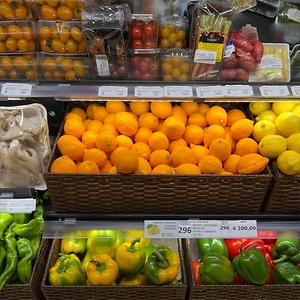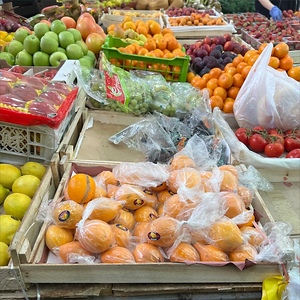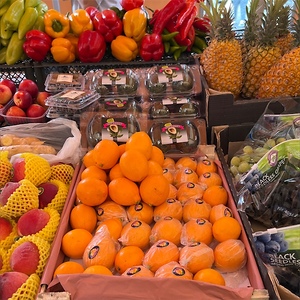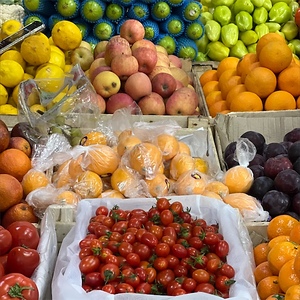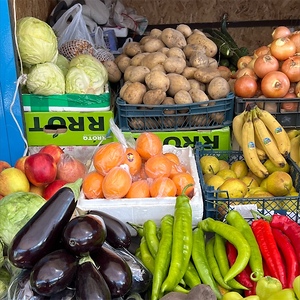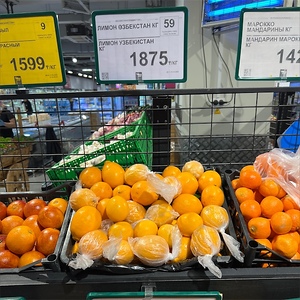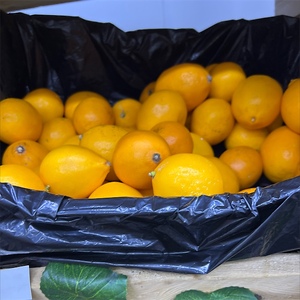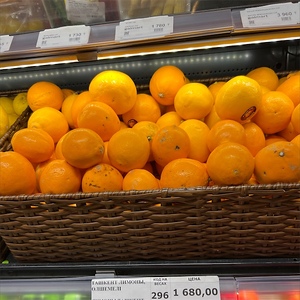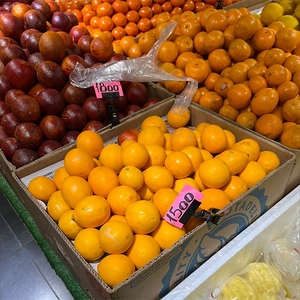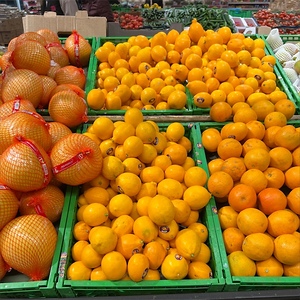


Uzbek Lemons
Estimated Inventory, lb : 0
Description/Taste
Uzbek lemons are a small to medium-sized varietal, generally weighing between 80 to 100 grams at harvest. Some fruits may be larger, depending on growing conditions and maturity, but overall, they are regarded as a smaller cultivar. The skin is thin, smooth, taut, and delicate, being easily punctured, torn, or bruised as it measures 0.2 to 0.5 mm in thickness. The orange skin also features prominent oils glands that give the surface a slightly pebbled, glossy, and oily feel. Underneath the skin, the orange flesh is dense, aqueous, and succulent, divided into 8 to 10 sections through thin membranes. The flesh is said to have a softer consistency than other types of lemons and is reminiscent of the texture of a clementine. The flesh also encases a few ivory to cream-colored seeds. Uzbek lemons exude a fragrant, bright, zesty, and rich aroma when sliced or torn open. The flesh is edible raw once ripe and has a sweet and sour taste with subtle fruity and floral nuances.
Seasons/Availability
Uzbek lemons are typically available in the fall, with a peak season from September through November.
Current Facts
Uzbek lemons, botanically a part of the Citrus genus, is a hybrid variety belonging to the Rutaceae family. The distinctly colored fruits are one of the most popular lemon varieties in Uzbekistan and were developed in the late 20th century as the first successful cultivar raised in the country. Uzbek lemons are also known as Tashkent, Tashkent-1, and Fakhritdinov-1 lemons. The variety grows on compact trees reaching 1.5 to 2.5 meters in height and is favored for its disease resistance and low maintenance. Since its release, Uzbek lemons are seasonally sold through markets across Uzbekistan and are viewed as a medicinal and culinary ingredient. The variety is known for its sweet and sour flavor and is used in a wide array of sweet and savory culinary preparations.
Nutritional Value
Uzbek lemons are said to be a source of vitamins A, C, and E, and multiple B vitamins. Vitamin C helps to strengthen the immune system, vitamin A maintains healthy organ functioning, while vitamin E guards the cells against the damage caused by free radicals. Uzbek lemons also provide fiber to regulate the digestive tract and some minerals, including calcium, magnesium, potassium, and iron. Calcium helps to support bones and teeth, magnesium controls nerve functions, and potassium balances fluid levels within the body. Iron develops the protein hemoglobin for oxygen transport through the bloodstream, and the fruits also contain other nutrients, including phosphorus, manganese, copper, and zinc. In Uzbekistan, lemon juice is often added to tea and consumed as a winter drink and the juice is mixed with honey to soothe sore throats. Lemon juice is also consumed as a way to fight off seasonal colds, flu, and other sicknesses.
Applications
Uzbek lemons have a sweet and sour taste suited for fresh and cooked preparations. The lemons are traditionally used out of hand and are squeezed for their aromatic juice. Uzbek lemons are popularly used to make variations of lemonade. They are also added to tea, cocktails, and other beverages. One distinct feature of the variety is its thin skin. Some consumers choose to peel the lemons like an orange and eat the flesh in small pieces, oftentimes with sugar. Uzbek lemons are considered desserts lemons and are a versatile variety without the overpowering bitterness. Cut pieces of the lemon can be added to meat main dishes, rice pilaf, or seafood entrees. The juice can also be squeezed into soups and stews or folded into butter for enhanced flavoring. In addition to savory preparations, Uzbek lemons are popularly used to flavor cakes, mousse, pies, and cookies. Uzbek lemons are famous in Uzbekistan for their delicate peels when candied and the juice is added into well-known desserts, including parvada, also known as Uzbek caramels, and nishalda, a whipped-cream-like dessert. Uzbek lemons are also added as a subtle tangy and acidic ingredient in pashmak, an ancient sweet that has a similar feel and consistency to cotton candy. Uzbek lemons pair well with herbs such as mint, basil, thyme, and rosemary, honey, spices including ginger, cumin, coriander, and garlic, cucumber, strawberries, and grapes. Whole, unwashed Uzbek lemons should be immediately used after purchase for the best quality and flavor. The variety has a short shelf life and will only last a few days to weeks when stored in the refrigerator.
Ethnic/Cultural Info
Uzbek lemons were once taken into space by Vladimir Aleksandrovich Dzhanibekov, a former cosmonaut originally from Uzbekistan. Cosmonaut shares the same meaning as astronaut, but specifically refers to scientists who were trained and sent to space by the Russian Space Agency. Mr. Dzhanibekov made five different flights to space and spent approximately 145 days, 15 hours, and 56 minutes in space over his career. He is considered one of the most experienced cosmonauts within the Russian space program and is known for advancements in various scientific studies. On one of his space flights, it is rumored that Mr. Dzhanibekov conducted a test to study the effect that lemons had on crew members when they were adjusting to weightlessness. Uzbek lemons were used in this study and were thought to have helped the crewmembers adjust at a faster rate, helping them overcome issues associated with weightlessness.
Geography/History
Uzbek lemons are native to Uzbekistan and were developed in the late 20th century. Lemon cultivation in Uzbekistan began in the 1940s when several varieties from Georgia were introduced for evaluation and research purposes. Uzbekistan is known for its continental climate, meaning it has very hot summers and very cold winters. This climate was challenging for lemon cultivation, ultimately leading to the trees not taking root. Efforts were made for over ten years before the Uzbek government decided to halt cultivation and funding for the program in 1955. Later in the 1960s, agricultural scientist and agronomist Zainiddin Fakhriddinov revisited the possibility of lemon cultivation in Uzbekistan and began grafting frost resistant citrus varieties. Mr. Fakhriddinov grafted a Meyer lemon onto a Novogruzinsky tree, a variety from Georgia, and the tree bore fruit in 1967. The fruits were distinct in coloring, flavor, and aroma, and quickly attracted attention from other lemon growers. Mr. Fakhriddinov initially named the variety Fakhritdinov-1, but over time, the cultivar became known as Tashkent and Uzbek lemons. Today, Uzbek lemons are one of the most popular varieties sold domestically throughout Uzbekistan and are also exported as a specialty citrus. Uzbek lemons are primarily cultivated in limonariums, or specialized types of greenhouses used for citrus cultivation in the regions of Fergana, Surkhandarya, Tashkent, and Kashkadarya in Uzbekistan. When in season, Uzbek lemons are sold through local markets in its growing region. They are also exported to Russia, Kazakhstan, Kyrgyzstan, Afghanistan, and China.



